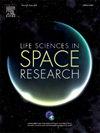在国际空间站轨道上进行35天和75天的超氧化物歧化酶模拟治疗,并在地球上恢复120天后进行关节保存。
IF 2.8
3区 生物学
Q2 ASTRONOMY & ASTROPHYSICS
引用次数: 0
摘要
航天飞行期间负重减少与肌肉骨骼退化有关,这对宇航员在运输途中和抵达深空目的地时的健康和表现构成威胁。先前在国际空间站(ISS)上进行的啮齿动物实验已经确定,太空飞行诱导的分子关节炎表型以氧化应激增加为特征。本研究评估了在轨道上使用超氧化物歧化酶(SOD)模拟物治疗是否可以预防太空飞行对啮齿动物膝关节和髋关节关节软骨以及半月板的损伤。通过显微ct、组织学和转录组学测量小鼠的软骨和半月板降解情况:(1)在国际空间站上停留35天,(2)在国际空间站上停留35天,然后在地球上负重适应120天,或(3)在国际空间站上停留75天。该研究样本量有限,因此报告了显著的效果和普遍的模式。在国际空间站上35天后,胫骨-股骨软骨-软骨接触点的软骨体积减小,半月板体积减小,同时关节软组织中促骨关节炎信号增加。同样,观察到胫骨皮质骨和小梁骨体积的减少。在国际空间站上35天后,用SOD模拟物治疗可以保护小梁骨、关节软骨和半月板,但在负重120天后和在轨道上75天后,恢复的效果有限。包括BuOE在内的抗氧化剂可作为航天飞行任务期间保护肌肉骨骼健康的潜在对策选择,并且在到达目的地后可能有必要继续使用。本文章由计算机程序翻译,如有差异,请以英文原文为准。
Treatment with a superoxide dismutase mimetic for joint preservation during 35 and 75 days in orbit aboard the international space station, and after 120 days recovery on Earth
Reduced weight-bearing during spaceflight has been associated with musculoskeletal degradation that risks astronaut health and performance in transit and upon reaching deep space destinations. Previous rodent experiments aboard the international space station (ISS) have identified that the spaceflight-induced molecular arthritic phenotype was characterized with an increase in oxidative stress. This study evaluated if treatment with a superoxide dismutase (SOD) mimetic on orbit could prevent spaceflight-induced damage to the knee and hip articular cartilage, and the menisci in rodents. Cartilage and meniscal degradation in mice were measured via microCT, histology, and transcriptomics after: (1) ∼ 35 days on the ISS, (2) ∼ 35 days on the ISS followed by 120 days weight-bearing readaptation on Earth or (3) ∼ 75 days on the ISS. The study had a limited sample size, so both significant effects and generalized patterns are reported. After 35 days aboard the ISS, cartilage volume at the tibial-femoral cartilage-cartilage contact point decreased, meniscal volume decreased concurrent with an increase in pro-osteoarthritic signaling in the joint soft tissue. Similarly, a decrease in cortical and trabecular bone volume of the tibia was observed. Treatment with the SOD mimetic preserved the trabecular bone, articular cartilage and the menisci after 35 days aboard the ISS, but had limited efficacy retaining that recovery after 120 days of weight bearing, and after 75 days on orbit. Antioxidants including BuOE may serve as a potential countermeasure option to protect musculoskeletal health during spaceflight missions, and continued use may be necessary upon reaching a destination.
求助全文
通过发布文献求助,成功后即可免费获取论文全文。
去求助
来源期刊

Life Sciences in Space Research
Agricultural and Biological Sciences-Agricultural and Biological Sciences (miscellaneous)
CiteScore
5.30
自引率
8.00%
发文量
69
期刊介绍:
Life Sciences in Space Research publishes high quality original research and review articles in areas previously covered by the Life Sciences section of COSPAR''s other society journal Advances in Space Research.
Life Sciences in Space Research features an editorial team of top scientists in the space radiation field and guarantees a fast turnaround time from submission to editorial decision.
 求助内容:
求助内容: 应助结果提醒方式:
应助结果提醒方式:


